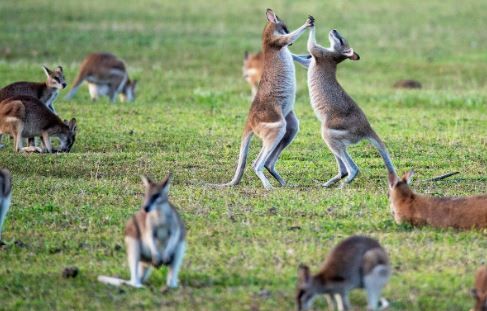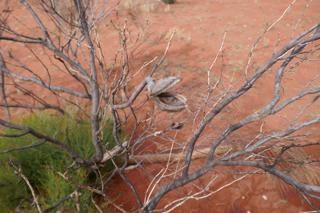The 6 seasons of the Kimberley

The Yawuru people have been the traditional owners of the lands and seas around Broome (Nileribanjen) in the Kimberley for tens of thousands of years and their community observes the traditional laws and customs laid out for them by their ancestors.
This includes the Yawuru calendar in which the locals recognise 6 seasons characterised by changes in their surrounding environment – Man-gala, Marrul, Wirralburu, Barrgana, Wirlburu and Laja.
I wanted to learn more about these seasons and have used details from absoluteoceancharters.com.au to take a look at each one.

Man-gala (December–March)
This is the wet season when strong northwest winds usher the rains in from across the Indian Ocean. Glorious sunsets and spectacular storms illuminate the sky throughout the duration of this season. It's also cyclone season!
Barn Swallows, ducks, snakes are evident with an abundance of flies. Yams are plentiful, cocky apples ripen and flying foxes can be seen soaring through the evening sky from the mangroves to the fruit trees in search of their next meal.
The local Yawuru people would seek shelter from the monsoonal weather inside their huts and ropes crafted out of Pindan Wattle help secure them, during intense storms and cyclones.1



Marrul (April)
The shortest season and begins at the end of the wet season, around the start of April. Hot and humid conditions continue to span across the vast landscape throughout - the rain will end, the tide will rise, and the wind dies down. Seasonal watering holes are full of budding life and grasses high from preceding rainfall.
Dragonflies^ mark the beginning of this short season, along with the budding of the native inland Bloodwood trees found along river flats and scree slopes. The Yawuru people used parts of the Bloodwood trees to create traditional medicines, spears, digging bowls and transportation vessels.
Lizards are fat due to the abundance of insects from the previous season, birds flock to the land in search of food and shelter.1
^Keep a look out for my post on dragonflies - coming soon.



Wirralburu (May)
The southeast winds strengthen, bringing cooler weather from the desert and dew in the evening. A cooling period in Broome, dry with warm to moderate temperatures during the day but cooling down during the night.
The salmon are biting and the native inland bloodwood trees flowering. Many species of native Acacias also flower during this period including the Pindan Wattle and Soap trees, spreading far and wide along the Nileribanjen landscape. The bush onion – an important food source for the Yawuru people for tens of thousands of years — ripens during this season, ready to be consumed once harvested from the ground.
Kangaroos, wallabies, and honey eaters provide the Yawuru locals with other food options as the lizards return underground to hibernate. Hunting is easier due to the drop in temperature on land during this period.1



Barrgana (June – August)
Cold days and even colder nights set in with fog occurring at the beginning and end of this season, as the warmer air interacts with the cold. Dry south-easterly winds continue to strengthen, forcing cooler weather in from across the desert. Although dry, there is also a chance of winter rainfall.
Now whales can be seen migrating north along the coast and seafood is plentiful
Bunung and Conkerberries ripen, and bush onions are abundant. Land based animals such as the kangaroo, wallaby, and possums are popular menu items for locals during this season.1

Wirlburu (September)
A transition period from the cold into the hot season as the westerly wind starts to blow and the warmer weather starts to set in. Days become hotter and nights warmer as cloud cover begins to engulf the sky. The mist trickles in from across the ocean as seaweed washes up against the shore.
Acacia pods begin to dry out, along with the remaining bush onions still submerged underground. The remaining onions become inedible while the wild pear starts to flower.
Reef fish such as sea perch, rock cod and various species of snapper and bream hit maturity along with a range of tasty shellfish such as mud cockles, mangrove crabs and pearl oysters. Low spring tides allow locals access to the reefs that house these animals.
On land during Wirlburu the Yawuru people collect the eggs of popular bird species such as the turkey and snipes. The turkey’s themselves along with other small birds become prime targets and a valuable food source.1




Laja (October – November)
A build-up period before the much-anticipated rains start to fall,temperatures soar, and humidity rises as the easterly winds bring hot air to the region from across the desert.
Shelters are made out of wood, bark, and other materials in preparation for the beginning of the wet season. The wild pear and cocky apples bear fruit but are not quite ripe for the picking just yet. The seed pods of a variety of native acacia trees including the pindan wattle and soap tree have split open and the white gum trees in the area begin to flower. The flower of the white gum trees attracts honey flies, which build honey nests in the Inland Bloodwood and Jigal trees before being collected by the Yawuru locals and eaten; the bush berries are ripe and ready to be picked.
Mating season begins for the various turtle species in the area this time of year as they venture up onto the shore to lay their eggs and there is an abundance of stingrays.1
...and so the cycle commences again!
Credits
1. absoluteoceancharters.com.au
